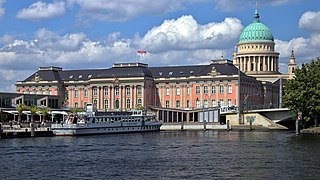
Potsdam is the capital and, with around 183,000 inhabitants, largest city of the German state of Brandenburg. It is part of the Berlin/Brandenburg Metropolitan Region. Potsdam sits on the River Havel, a tributary of the Elbe, downstream of Berlin, and lies embedded in a hilly morainic landscape dotted with many lakes, around 20 of which are located within Potsdam's city limits. It lies some 25 kilometres southwest of Berlin's city centre. The name of the city and of many of its boroughs are of Slavic origin.

Carl Philipp Christian von Gontard was a German architect who worked primarily in Berlin, Potsdam, and Bayreuth in the style of late Baroque Classicism. Next to Knobelsdorff, he was considered the most important architect of the era of Frederick the Great of Prussia.

(Hans) Georg Wenzeslaus von Knobelsdorff was a painter and architect in Prussia.

The Orangery Palace is a palace located in the Sanssouci Park of Potsdam, Germany. It is also known as the New Orangery on the Klausberg, or just the Orangery. It was built on behest of the "Romantic on the Throne", King Friedrich Wilhelm IV from 1851 to 1864.

The Temple of Friendship is a small, round building in Sanssouci Park, Potsdam, in Germany. It was built by King Frederick II of Prussia in memory of his sister, Princess Wilhelmine of Prussia, who died in 1758. The building, in the form of a classical temple, was built south of the park's main boulevard between 1768 by architect Carl von Gontard. It complements the Temple of Antiquities, which lies due north of the boulevard on an axis with the Temple of Friendship.

The Protestant Church of Peace is situated in the Marly Gardens on the Green Fence in the palace grounds of Sanssouci Park in Potsdam, Germany. The church was built according to the wishes and with the close involvement of the artistically gifted King Frederick William IV and designed by the court architect, Ludwig Persius. After Persius' death in 1845, the architect Friedrich August Stüler was charged with continuing his work. Building included work by Ferdinand von Arnim and Ludwig Ferdinand Hesse also. The church is located in the area covered by the UNESCO World Heritage Site Palaces and Parks of Potsdam and Berlin.

The Neptune Grotto close to the Obelisk entrance in Sanssouci Park, Potsdam, was created by Frederick the Great between 1751 and 1757 to beautify the park.

The New Chambers is part of the ensemble of Sanssouci palace in Sanssouci Park, Potsdam, Germany. They were constructed for King Frederick the Great of Prussia from 1771 to 1775.
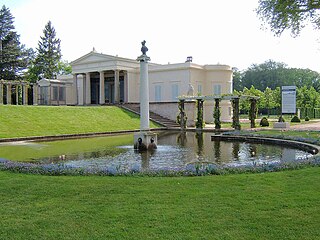
Charlottenhof Palace or Charlottenhof Manor is a former royal palace located southwest of Sanssouci Palace in Sanssouci Park at Potsdam, Germany. It is best known as the summer residence of Crown Prince Frederick William. Today it is maintained by the Prussian Palaces and Gardens Foundation Berlin-Brandenburg.

The Ruinenberg is a hill in the Bornstedt borough of Potsdam, located north of Sanssouci Park. In 1748, the Prussian king Frederick the Great had a water tank with a capacity of around 7,600 cubic metres (270,000 cu ft) built on top to supply the Sanssouci water features, and had it decorated with artificial ruins. From 1841 a surrounding landscape garden was laid out at the behest of King Frederick William IV of Prussia, according to plans designed by Peter Joseph Lenné.

Dragon House is a historical building in Potsdam, Germany, built by King Frederick the Great of Prussia on the southern slope of the Klausberg, which borders the northern edge of Sanssouci Park. It was constructed between 1770 and 1772 in the prevailing Chinoiserie taste of the time, designed to imitate a Chinese pagoda. Carl von Gontard was commissioned to build it. The house served as the residence of the vineyard's vintner.

The Antique Temple is a small round temple in the west part of Sanssouci Park in Potsdam. Frederick the Great had the building constructed to house his collection of classical works of art, antique artifacts, coins and antique gems. Carl von Gontard created the building in 1768/69 near the New Palace north of the Central Alley, as a complement to the Temple of Friendship situated south of the Alley. Since 1921 the Antique Temple has been used as a mausoleum for members of the House of Hohenzollern and is not open to the public.

The New Palace is a palace situated on the western side of the Sanssouci park in Potsdam, Germany. The building was begun in 1763, after the end of the Seven Years' War, under King Friedrich II and was completed in 1769. It is considered to be the last great Prussian Baroque palace.
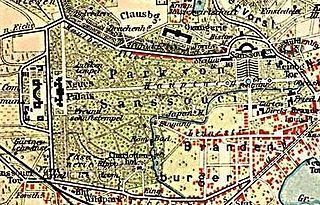
Sanssouci Park is a large park surrounding Sanssouci Palace in Potsdam, Germany, built under Frederick the Great in the mid-1700s. Following the terracing of the vineyard and the completion of the palace, the surroundings were included in the structure. A Baroque flower garden with lawns, flower beds, hedges and trees was created. In the hedge quarter 3,000 fruit trees were planted. The greenhouses of the numerous nurseries contained oranges, melons, peaches and bananas. The goddesses Flora and Pomona, who decorate the entrance obelisk at the eastern park exit, were placed there to highlight the connection of a flower, fruit and vegetable garden. Along with the Sanssouci Palace and other neaby palaces and parks, Sanssouci Park was inscribed on the UNESCO World Heritage List in 1990 for its unique architectural unity and testimony to 18th and 19th century landscaping in Europe.
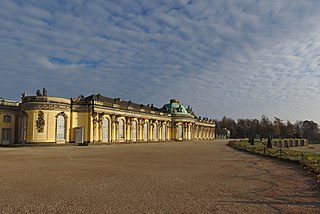
Sanssouci is a historical building in Potsdam, near Berlin. Built by Prussian King Frederick the Great as his summer palace, it is often counted among the German rivals of Versailles. While Sanssouci is in the more intimate Rococo style and is far smaller than its French Baroque counterpart, it, too, is notable for the numerous temples and follies in the surrounding park. The palace was designed and built by Georg Wenzeslaus von Knobelsdorff between 1745 and 1747 to meet Frederick's need for a private residence where he could escape the pomp and ceremony of the royal court. The palace's name is a French phrase that translates as "without concerns", meaning "without worries" or "carefree", emphasising that the palace was meant as a place of relaxation, rather than a seat of power.

The Marmorpalais is a former royal residence in Potsdam, near Berlin in Germany, built on the grounds of the extensive Neuer Garten on the shores of the Heiliger See (lake). The palace was commissioned by King Friedrich Wilhelm II and designed in the early Neoclassical style by the architects Carl von Gontard and Carl Gotthard Langhans. The palace remained in use by the Hohenzollern family until the early 20th century. It served as a military museum under communist rule, but has since been restored and is once again open to the public.

The New Garden in Potsdam is a park of 102.5 hectares located southwest of Berlin, Germany, in northern Potsdam and bordering on the lakes Heiliger See and Jungfernsee. Starting in 1787, Frederick William II of Prussia (1744-1797) arranged to have a new garden laid out on this site, and the design and landscaping was carried out by Johann August Eyserbeck, who had previously worked on the Dessau-Wörlitz Garden Realm.
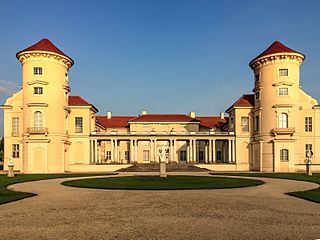
Rheinsberg Palace lies in the municipality of Rheinsberg, about 100 kilometres (62 mi) northwest of Berlin in the German district of Ostprignitz-Ruppin.

The Old Market Square is a centrally located square in downtown Potsdam which forms the historical centre of the city. The square consists of the area around St. Nicholas' Church. Today the term refers in particular to the area directly in front of the church. It is bordered by several prestigious historical buildings. The square has been the site of much architectural reconstruction work in recent years which has restored much historic building fabric that was lost in World War Two.




















